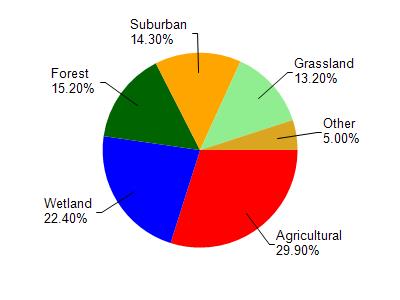Waukesha
No
No
No
Fish and Aquatic Life
Overview
School Section Lake, in the Bark River Watershed, is a 122.07 acre lake that falls in Waukesha County. This lake is managed for fishing and swimming and is currently considered impaired.
Date 2015
Author Aquatic Biologist
Historical Description
Source: 1963, Surface Water Resources of Waukesha County School Section Lake T6N, R17E, Sections 16 and 17
A small lake occupying a depression in the bed of a minor glacial lake. In 1938, a dike and spillway were constructed raising the water level four feet and creating the present lake. Since that time, an extensive ditching system has supplemented the naturalwater supply. A ditched outlet stream flows to the Bark River. The lake is presently managed for northern pike, pan fish and largemouth bass. As with most swamp drainage lakes, the water is brown and relatively turbid. Carp are present but may be beneficial in that they may partially control rooted vegetation so abundant in this lake. The lake has a history of winterkill, however none has occurred in recent years. Public access is available at a county-owned launching site and from road frontage. Adjoining wetlands have considerable value for upland game and waterfowl production.
Surface Acres = 125, S.D.F. = 1.21, Maximum Depth = 12 feet
Date 1963
Author Surface Water Inventory Of Wisconsin
General Condition
School Section Lake (WBIC 825000) was placed on the impaired waters list for total phosphorus in 2014. This water was assessed during the 2018 listing cycle; new total phosphorus and chlorophyll-a sample data were clearly below the 2018 WisCALM listing thresholds for the Recreation use and the Fish and Aquatic Life use. This water was meeting these designated uses and was not considered impaired. This lake was proposed for delisting in 2018.
Date 2017
Author Ashley Beranek
Impaired Waters
School Section Lake (825000) was placed on the impaired waters list for total phosphorus in 2014. The 2016 assessments showed continued excess algal growth; chlorophyll sample data exceed 2016 WisCALM listing thresholds for the Recreation use, however, total phosphorus did not exceed REC thresholds. Total phosphorus and chlorophyll data were clearly below Fish and Aquatic Life listing thresholds. This water was also assessed for temperature and sample data did not exceed 2016 WisCALM listing criteria for the Fish and Aquatic Life use. Based on the most updated information the impairment of Excess Algal Growth was added to this listing.
Date 2015
Author Aaron Larson
Condition
Wisconsin has over 84,000 miles of streams, 15,000 lakes and milllions of acres of wetlands. Assessing the condition of this vast amount of water is challenging. The state's water monitoring program uses a media-based, cross-program approach to analyze water condition. An updated monitoring strategy (2015-2020) is now available. Compliance with Clean Water Act fishable, swimmable standards are located in the Executive Summary of Water Condition in 2018. See also the 'monitoring and projects' tab.
Reports
Recommendations
Social Survey of Residents or Users
Aquatic Plant Monitoring or Survey
Aquatic Plant Management Plan
Water Quality Modeling
Management Goals
Wisconsin's Water Quality Standards provide qualitative and quantitative goals for waters that are protective of Fishable, Swimmable conditions [Learn more]. Waters that do not meet water quality standards are considered impaired and restoration actions are planned and carried out until the water is once again fishable and swimmable
Management goals can include creation or implementation of a Total Maximum Daily Load analysis, a Nine Key Element Plan, or other restoration work, education and outreach and more. If specific recommendations exist for this water, they will be displayed below online.
Monitoring
Monitoring the condition of a river, stream, or lake includes gathering physical, chemical, biological, and habitat data. Comprehensive studies often gather all these parameters in great detail, while lighter assessment events will involve sampling physical, chemical and biological data such as macroinvertebrates. Aquatic macroinvertebrates and fish communities integrate watershed or catchment condition, providing great insight into overall ecosystem health. Chemical and habitat parameters tell researchers more about human induced problems including contaminated runoff, point source dischargers, or habitat issues that foster or limit the potential of aquatic communities to thrive in a given area. Wisconsin's Water Monitoring Strategy was recenty updated.
Grants and Management Projects
Monitoring Projects
| WBIC | Official Waterbody Name | Station ID | Station Name | Earliest Fieldwork Date | Latest Fieldwork Date | View Station | View Data |
|---|
| 825000 | School Section Lake | 684012 | School Section Lake - School Section Lake | 9/5/1979 | 9/5/1979 | Map | Data |
| 825000 | School Section Lake | 10007235 | School Section Lake | 6/1/1995 | 9/30/2017 | Map | Data |
| 825000 | School Section Lake | 10017555 | School Section Lake -- Access | 6/10/2006 | 6/3/2025 | Map | Data |
| 825000 | School Section Lake | 683251 | School Section Lake - Deep Hole | 9/18/1980 | 9/4/2025 | Map | Data |
|

Watershed Characteristics
School Section Lake is located in the Bark River watershed which is 185.84 mi². Land use in the watershed is primarily agricultural (29.90%), wetland (22.40%) and a mix of forest (15.20%) and other uses (32.50%). This watershed has 265.69 stream miles, 3,499.26 lake acres and 22,145.94 wetland acres.
Nonpoint Source Characteristics
This watershed is ranked Medium for runoff impacts on streams, High for runoff impacts on lakes and High for runoff impacts on groundwater and therefore has an overall rank of High. This value can be used in ranking the watershed or individual waterbodies for grant funding under state and county programs.However, all waters are affected by diffuse pollutant sources regardless of initial water quality. Applications for specific runoff projects under state or county grant programs may be pursued. For more information, go to surface water program grants.